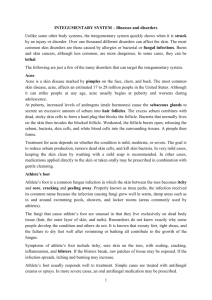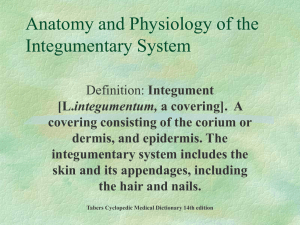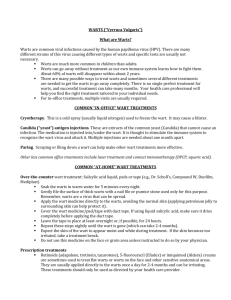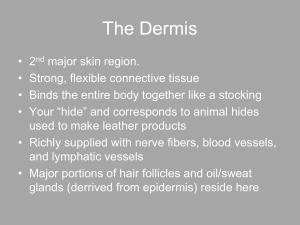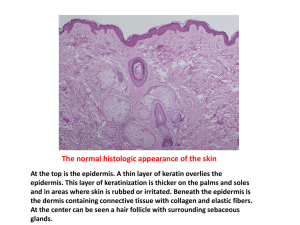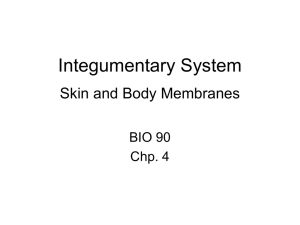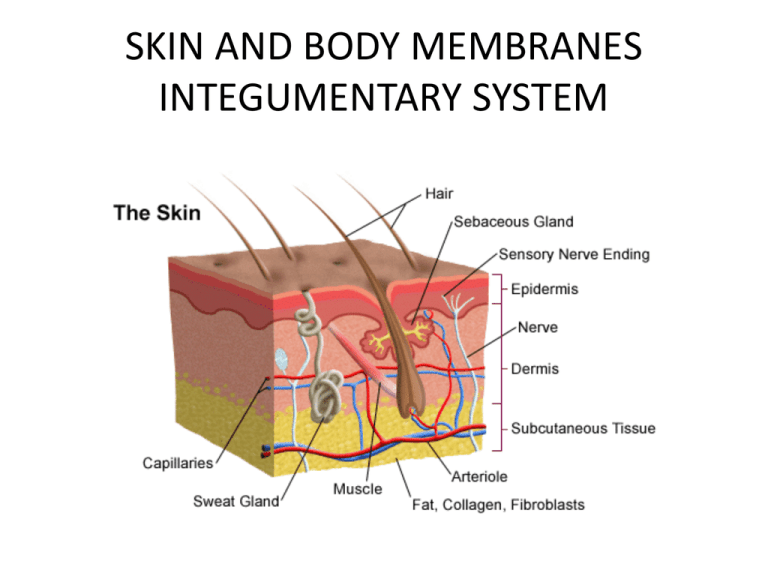
SKIN AND BODY MEMBRANES
INTEGUMENTARY SYSTEM
EPITHELIAL MEMBRANES
• There are 3 types of
epithelial membranes
– Cutaneous membrane
– Mucus membrane
– Serous membrane
Cutaneous
Membrane
Skin
Dry Membrane
Mucous
Membrane
Lines all body cavities that
are open to the exterior.
ex: Respiratory, digestive,
urinary, and reproductive
Moist membrane
Serous
Membrane
Lines cavities that are
closed to the exterior.
Occur in pairs.
Reduces friction, especially
in organs that move
Ex: heart, stomach, lungs
(Think of a pushed in balloon. The
space between is not filled with air but
serous fluid.)
INTEGUMENTARY SYSTEM
(SKIN, HAIR, NAILS)
• Basic Functions
– Synthesizes vitamin D
– Excretion of urea and salts
– Protects deeper tissue from:
•
•
•
•
•
•
Mechanical damage
Chemical damage
Bacteria
Ultraviolet radiation
Thermal damage
Drying out
STRUCTURE OF THE SKIN
• There are 3 major layers of the skin
– Epidermis
– Dermis
– Hypodermis (subcutaneous tissue/layer)
EPIDERMIS
•
•
•
•
•
•
•
•
Outer layer
Made up of squamous epithelium
that can be keratinized (hard or
tough)
Melanocytes found in deepest layer
– gives skin its color.
Mostly dead cells
Avascular – no blood vessels.
Mostly keratinocyte cells. They
produce keratin, which is a protein
that makes the epidermis a tough
layer.
New cells are produced constantly
and pushed upward.
New epidermal layer every 2-4
weeks
DERMIS
• Found under the epidermis (2nd
layer)
• Made up of dense connective
tissue.
• Varies in thickness
• The epidermis and dermis are
connected but rubbing may cause
them to separate resulting in a
blister
• Structures found in the dermis
include: papillary layer,
sebaceous glands, sweat glands,
hair, hair follicle, erector pilli,
blood vessels.
STRUCTURES IN THE DERMIS
PAPILLARY LAYER
• Upper layer of the dermis.
• Has finger like projections
called dermal papillae which
on the hands and feet are
arranged in definite patters
that form ridges.
• They enhance the gripping
ability of the fingers and feet
• Patterns are genetically
determined & form your
fingerprints.
STRUCTURES IN THE DERMIS
Sebaceous glands
• Also known as oil
glands
• Keep skin moist
and prevents hair
from becoming
brittle by
producing sebum
• Contains
chemicals that
kill bacteria.
• When sebum
blocks the glands
duct, a
whitehead
appears.
• Acne is an
infection of the
sebaceous
glands.
STRUCTURES IN THE DERMIS
Sweat Glands
• Produce sweat which is
acidic (pH 4-6)
• Inhibits bacteria and gets
rid of excess heat
STRUCTURES IN THE DERMIS
Hair & the hair follicle
• Hair is produced by a
hair follicle.
• The root is enclosed
by the follicle and
the shaft is
projecting from the
surface.
• Cuticle – outer most
layer of hair in which
cells overlap like
layers on a roof.
• When the cuticle
wears away, “split
ends” occur because
the inner fibers frizz
out.
HYPODERMIS/SUBCUTANEOUS TISSUE
• Adipose tissue (Fat)
• Shock absorber
• Insulates
MELANIN
• A pigment that ranges in color from yellow to brown to black.
• Produced by cells called melanocytes.
• Sunlight causes melanin to be produced & deepest cells of the
epidermis.
• Melanin forms a protective umbrella over the nucleus of the
cells. Protects against ultraviolet radiation from sunlight.
Melanin
• Freckles and moles are
seen when melanin is
concentrated in one
spot.
SUN EXPOSURE
• Despite melanin’s
protection, excessive
sun exposure
eventually damages
skin.
• It causes elastic fibers
to clump, leading to
leathery skin.
• Sun exposure also
depresses the immune
system, can activate
cold sores, and alter
DNA and lead to skin
cancer.
DISCOLORATION OF SKIN
CYANOSIS
• A bluish coloring of the skin
when the blood is poorly
oxygenated.
JAUNDICE
• A yellow coloration to the
skin usually signifies a liver
disorder in which excess
bile pigments are absorbed
into the blood.
DISCOLORATION OF SKIN
BRUISES
• Site where blood has
escaped from the blood
vessels and has clotted in
tissue spaces
BURNS
A burn is damage to
your body's tissues
caused by heat,
chemicals,
electricity, sunlight
or radiation. Scalds
from hot liquids and
steam, building fires
and flammable
liquids and gases
are the most
common causes of
burns.
1ST DEGREE BURNS
First-degree burns, the
mildest of the three, are
limited to the top layer
of skin:
Signs and symptoms:
These burns produce
redness, pain, and minor
swelling. The skin is dry
without blisters.
Healing time: Healing
time is about 3 to 6
days; the superficial skin
layer over the burn may
peel off in 1 or 2 days.
Only the epidermis is damaged in 1st degree
burns.
2ND DEGREE BURNS
Second-degree burns are
more serious and involve
the epidermis and the
upper region of the
dermis.
Signs and symptoms:
These burns produce
blisters, severe pain, and
redness. The blisters
sometimes break open and
the area is wet looking
with a bright pink to cherry
red color.
Healing time: Healing time
varies depending on the
severity of the burn. It can
take up to 3 weeks or
more. Usually little to no
scarring if care is taken to
prevent infection.
3RD DEGREE BURNS
Third-degree burns are the most
serious type of burn and involve all
the layers of the skin and
underlying tissue:
Signs and symptoms: The surface
appears dry and can look waxy
white, leathery, brown, or charred.
There may be little or no pain or
the area may feel numb at first
because of nerve damage.
Healing time: Healing time
depends on the severity of the
burn. Deep second- and thirddegree burns (called full-thickness
burns) will likely need to be treated
with skin grafts, in which healthy
skin is taken from another part of
the body and surgically placed over
the burn wound to help the area
heal.
SKIN CANCER
• Basal Cell Carcinoma
• Squamous Cell
Carcinoma
• Malignant Melanoma
SKIN CANCER
Basal cell carcinoma
• Most common
• Least malignant
• Cells of the epidermis are
altered and no longer form
keratin but invade the
dermis and subcutaneous
tissue.
• Slow growing and 99% of
the cases are fully cured if
surgically removed.
SKIN CANCER
Squamous cell carcinoma
• Rapid growing
• Will spread to lymph nodes
if not removed
• Epidermal cancer
• If removed early, good
chance for complete
recovery
SKIN CANCER
Malignant melanoma
• Cancer of melanocytes
• Least common
• Often deadly
• Appears as a spreading
(metastasizing) brown to
black patch.
• Can invade surrounding
lymph and blood vessels.
• 50% survival rate; early
detection increases survival.
SKIN CANCER
SKIN DISORDERS
Psoriasis
Psoriasis is a common skin condition that
causes skin redness and irritation. Most
people with psoriasis have thick, red skin
with flaky, silver-white patches called
scales.
Psoriasis seems to be passed down
through families. Doctors think it
probably occurs when the body's immune
system mistakes healthy cells for
dangerous substances.
It is not contagious. Anyone can get
it, but it most commonly begins between
ages 15 and 35.
The following may trigger an attack of
psoriasis or make the condition more
difficult to treat:
Bacteria or viral infections, including strep
throat and upper respiratory infections
Dry air or dry skin
Injury to the skin, including cuts, burns,
and insect bites
Some medicines, including anti-malaria
drugs, beta-blockers, and lithium
Stress
Too little sunlight
Too much sunlight (sunburn)
Too much alcohol
Psoriasis continued
Symptoms
•
•
•
•
•
•
•
•
•
•
•
•
•
Irritated, red, flaky patches of skin
Most often seen on the elbows, knees,
and middle of the body
Red patches may appear anywhere on the
body, including the scalp
The skin may be:
Itchy
Dry and covered with silver, flaky skin
(scales)
Pink-red in color (like the color of salmon)
Raised and thick
Other symptoms may include:
Genital lesions in males
Joint pain or aching
Nail changes, including thick nails, yellowbrown nails, dents in the nail, and nail lifts
off from the skin underneath
Severe dandruff on the scalp
Treatment
• Skin lotions, ointments,
creams, and shampoos.
These are called topical
treatments.
• Pills or injections that affect
the body's immune
response, not just the skin.
There are called systemic, or
body-wide, treatments.
• Phototherapy, which uses
light to treat psoriasis.
Boils
A boil is a skin infection
involving an entire hair follicle
and nearby skin tissue.
They are generally caused by
the bacteria Staphylococcus
aureus, but they may be
caused by other bacteria or
fungi found on the skin's
surface. Damage to the hair
follicle allows these bacteria
to enter deeper into the
tissues of the follicle and the
tissue underneath.
A boil may begin as a tender,
pinkish-red, swollen, firm area
in the skin. Over time, it will
feel like a water-filled balloon
or cyst.
Boils continued
Symptoms
Treatment
•
•
•
•
•
•
•
•
•
•
•
•
Is usually pea-sized, but may be as
large as a golf ball
May develop white or yellow
centers (pusteles)
May join with another boil or
spread to other skin areas
May grow quickly
May weep, ooze, or crust
Other symptoms may include:
Fatigue
Fever
General ill-feeling
Itching before the boil develops
Skin redness around the boil
•
•
•
•
Boils usually must open and drain
before they will heal. This usually
occurs in less than 2 weeks.
Warm, moist compresses help boils
drain, which speeds healing. Gently
soak the area with a warm, moist cloth
several times each day.
Never squeeze a boil or try to cut it
open at home. This can spread the
infection and make it worse.
When the boil finally does burst and
drain, continue to put warm, wet
compresses on the area.
Deep or large boils may need to be
drained with surgery by a health care
provider.
Warts
Warts are small, usually painless growths on the skin
caused by a virus called human papillomavirus (HPV).
Most, but not all, are generally harmless.
All warts can spread from one part of your own body
to another. They may spread from one person to
another, but this is uncommon.
Different types of warts include:
Common warts usually appear on the hands, but can
appear anywhere. They usually do not cause pain
unless they are repeated rubbed against.
Flat warts are generally found on the face and
forehead. They are common in children, less
common in teens, and rare in adults.
Genital warts(condyloma) are usually found on the
genitals, in the pubic area, and in the area between
the thighs, but they can also appear inside the vagina
and anal canal.
Plantar warts are found on the soles of the feet.
They can be very painful. Many of them on the foot
may cause difficulty walking or running.
Subungual and periungual warts appear under and
around the fingernails or toenails.
Warts continued
Symptoms
Treatment
• The typical wart is a raised
round or oval growth on the
skin with a rough surface.
• The spot may be lighter,
darker, or black (rare)
colored compared to other
skin.
• Some warts have smooth or
flat surfaces.
• Some warts cause pain,
others do not.
•
•
•
•
•
•
•
•
•
•
Do NOT attempt to remove a wart yourself
by burning, cutting, tearing, picking, or any
other method.
Over-the-counter medications are available
to remove warts. Do NOT use over-thecounter wart medications on your face or
genitals. Warts on the face or genitals need
to be treated by your doctor or nurse.
Your health care provider may recommend
the following treatments if your warts do
not go away:
Stronger (prescription) medications, such
as podophyllin or salicylic acid
A blistering solution
Freezing the wart (cryotherapy) to remove
it
Burning the wart (electrocautery) to
remove it
Laser treatment for difficult to remove
warts
Immunotherapy, which gives you a shot
of a substance that causes an allergic
reaction and helps the wart go away
Skin medicine called imiquimod
Rosacea
Rosacea is a chronic skin condition
that makes your face turn red and may
cause swelling and skin sores that look
like acne.
Rosacea is a harmless condition, but it
may cause you to be self-conscious or
embarrassed. The cause is not known.
You may be more likely to have this if
you are
Age 30-50
Fair-skinned
A woman (but men usually have more
severe symptoms)
Rosacea involves swelling of the blood
vessels just under the skin. It may be
associated with other skin disorders
(acne vulgaris, seborrhea) or eye
disorders (blepharitis, keratitis).
Rosacea continued
Symptoms
Treatment
• Redness of the face
• Blushing or flushing easily
• A lot of spider-like blood
vessels (telangiectasia) of the
face
• Red nose (called a bulbous
nose)
• Acne-like skin sores that may
ooze or crust
• Burning or stinging feeling in
the face
• Irritated, bloodshot, watery
eyes
•
•
•
•
•
•
•
•
There is no known cure for rosacea.
Your doctor will help you identify the things
that make your symptoms worse. These are
called triggers. Avoiding your triggers may
help you prevent or reduce flare-ups.
Here are some steps that may help ease or
prevent symptoms:
Avoid sun exposure. Use sunscreen every
day.
Avoid a lot of activity in hot weather.
Try to reduce stress. Try deep breathing,
yoga, or other relaxation techniques.
Limit spicy foods, alcohol, and hot beverages.
Triggers vary from person to person. Other
triggers may include wind, hot baths, cold
weather, specific skin products, exercise, or
other factors.
Rosacea continued
• Treatment (continued)
• Antibiotics taken by mouth (such as tetracycline,
minocycline, or doxycycline) or applied to the skin (such as
metronidazole) may control acne-like skin problems.
• Other medications (isoretinol or Accutane), which are
similar to vitamin A, are stronger alternatives that your
doctor or dermatologist might consider.
• Rosacea is not acne and will not improve with over-thecounter acne treatment.
• In severe cases, laser surgery may help reduce the redness.
Surgery to remove some swollen nose tissue may also
improve your appearance.
Impetigio
Impetigo, a skin infection, is caused by
streptococcus (strep) or staphylococcus (staph)
bacteria. Methicillin-resistant staph aureus (MRSA)
is becoming a common cause.
It is most common in children, particularly those in
unhealthy living conditions.
Involves the top layers of the skin.
Impetigo is contagious, meaning it can spread to
others. You can catch this infection if the fluid that
oozes from the blisters touches an open area on
your skin.
Diagnosis is based mainly on the appearance of the
skin lesion.
A culture of the skin or lesion usually grows the
bacteria streptococcus or staphylococcus. The
culture can help determine if MRSA is the cause,
because specific antibiotics are used to treat this
infection.
Impetigo continued
Symptoms
Treatment
• A single or possibly many blisters
filled with pus; easy to pop and -when broken -- leave a reddish
raw-looking base (in infants)
• Itching blister:
• The goal is to cure the
infection and relieve the
symptoms.
• A mild infection may be
treated with a prescription
antibacterial cream. More
severe cases may require
antibiotics, taken by mouth.
• Wash (do not scrub) the skin
several times a day, preferably
with an antibacterial soap, to
remove crusts and drainage.
– Filled with yellow or honey-colored
fluid
– Oozing and crusting over
• Rash -- may begin as a single
spot, but if person scratches, it
may spread to other areas
• Skin lesions on the face, lips,
arms, or legs, that spread to
other areas
• Swollen lymph nodes near the
infection (lymphadenopathy)
Jaundice continued
Symptoms
Treatment
• Yellow skin and the white
part of the eyes (sclera) -when jaundice is more
severe, these areas may
look brown
• Yellow color inside the
mouth
• Dark or brown-colored
urine
• Pale or clay-colored stools
• Treatment depends on the
cause of the jaundice.
Jaundice
Jaundice is a yellow color of the skin, mucus membranes,
or eyes. The yellow coloring comes from bilirubin, a
byproduct of old red blood cells. Jaundice can be a
symptom of other health problems.
Everyday, a small number of red blood cells in your body
die, and are replaced by new ones. The liver removes the
old blood cells, forming bilirubin. The liver helps break
down bilirubin so that it can be removed by the body in
the stool.
When too much bilirubin builds up in the body, jaundice
may result.
Jaundice can occur if:
Too many red blood cells are dying or breaking down and
going to the liver
The liver is overloaded or damaged
The bilirubin from the liver is unable to move through the
digestive tract properly
Jaundice is often a sign of a problem with the liver,
gallbladder, or pancreas. Infections, use of certain drugs,
cancer, blood disorders, gallstones, birth defects and a
number of other medical conditions can lead to jaundice.



